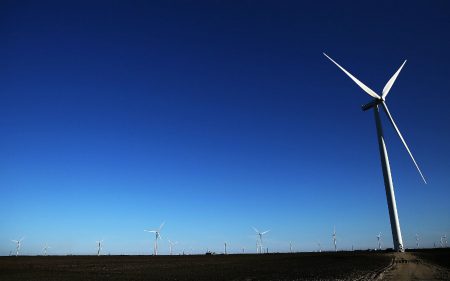September 2, 2017 – One concern that gets raised about wind energy relates to the ability of turbines to withstand extreme force winds from storms. Hurricane Harvey which came onshore on August 25, 2017, was classified as a Category 4 storm. That meant winds reached speeds of almost 210 kilometers (130 miles) per hour. and plowed directly into a number of Texas wind farms.
With Texas the largest producer of wind energy in the United States, this was a great test of the technology’s resilience. Harvey plowed directly into a number of Texas wind farms as it came ashore and all survived the pummeling as wind gusts exceeded 160 kilometers (100 miles) per hour. The turbines were not damaged. The grid, however, took a beating, meaning transmission of the electricity generated by the wind farms is currently off line until repairs can be made.
During the peak of the hurricane, wind farms were able to temporarily idle turbines to ensure they remained secure and safe. Although this temporarily reduced wind power by 800 megawatts at the height of the storm, none were damaged, and they were ready to generate electricity after the initial onslaught of severe winds. Only transmission infrastructure damage kept them from providing needed electricity to a battered state.
An interesting comparison can be made regarding the resilience of wind farms versus that of the fossil-fuel infrastructure found along the same coast where Harvey came ashore. The environmental impact of the storm, now that it has passed, is still being assessed, but currently, Texas’ refineries and chemical plants are in a mess with sewage overflows, numerous spills and leaks, and in one case a chemical plant that experienced an explosion and fire.
In total, more than 30 leaks had been reported as of August 30th. These include:
- A large but not fully determined volume of benzene from a refinery in Corpus Christi.
- 347,500 kilograms (766,000 pounds) of diverse chemicals from a Chevron plant in Baytown.
- A Dow chemical leak in Freeport releasing 15,000 kilograms (34,000 pounds) of benzene, toluene, carbon monoxide and other pollutants.
According to Environment Texas spokesperson, Luke Metzger, “people are already being exposed to cancer-causing chemicals.”
Since August 30th, Harvey has continued to dump rain onto existing fossil fuel infrastructure delaying the checking of refineries and delaying any attempts at restarts. There is continued concern that storage tank infrastructure has been damaged by rising floodwaters leading to pipeline breaks. Restarting the pumping of refinery products into these tanks may expose more leaks and spills.
The Chemical Safety and Hazard Investigation Board (CSB) of the United States has issued a warning to all oil and chemical processing facilities to ensure extra caution is applied to any facility restarts in anticipation that the flooding will create further damage.
For wind energy, Harvey has been a test to prove the resilience of this technology. It comes just a few days after solar energy infrastructure was tested by the solar eclipse, the latter seen as a potential Achilles heel for that renewable energy technology. But both have come through with flying colours.









